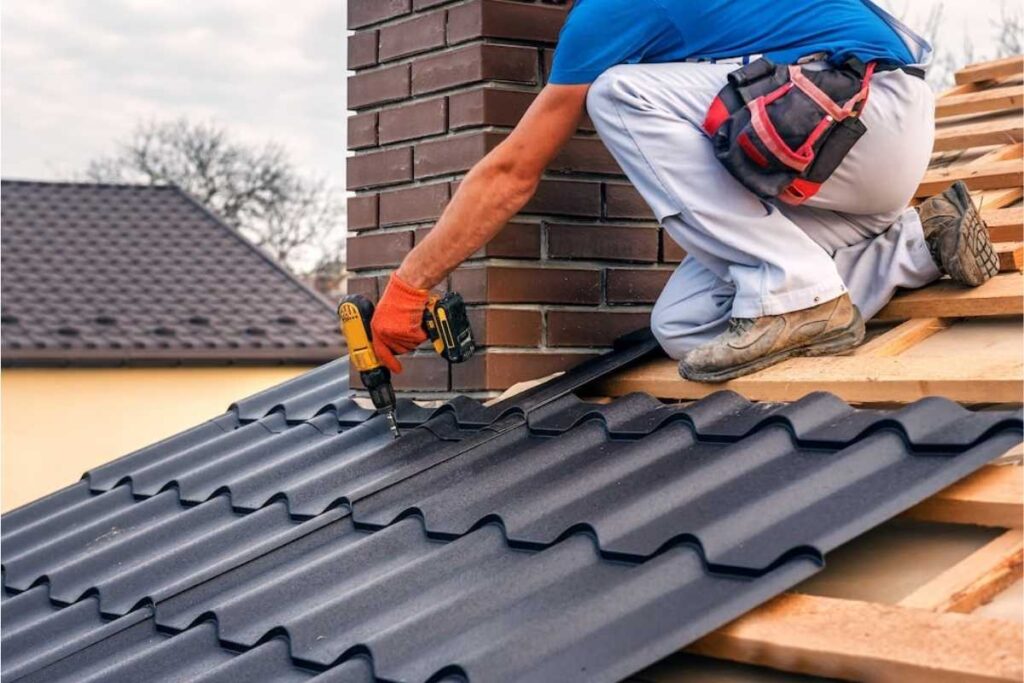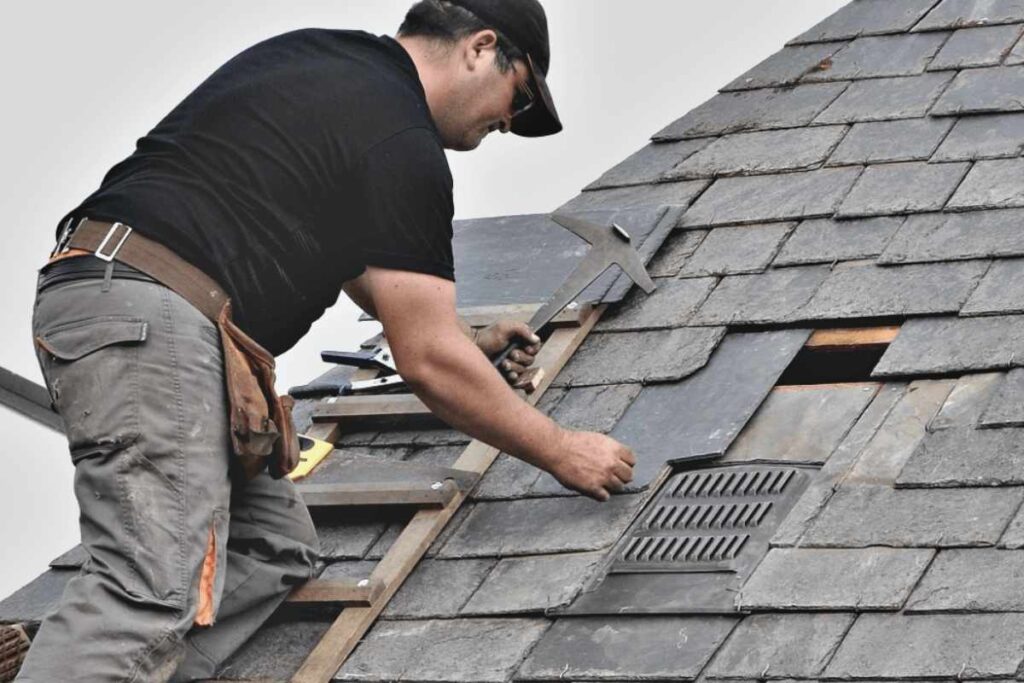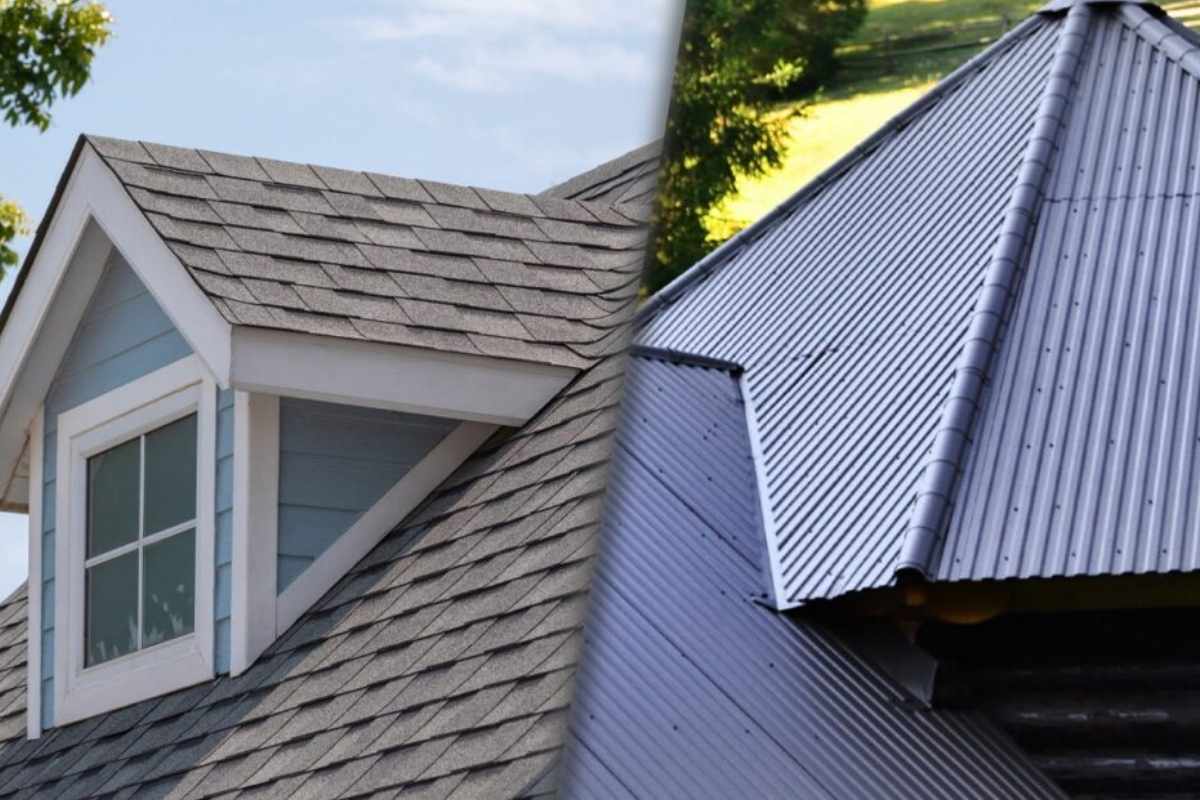Metal roof installations cost between $15,000 and $24,500 for an average home. Asphalt shingles are a more affordable option at $6,000 to $9,800. The price difference seems substantial at first glance, but when comparing the cost of metal roof vs shingle, there are long-term benefits to consider.
A metal roof’s lifespan extends up to 100 years, while asphalt shingles typically last 15-30 years. The higher original cost of metal roofing brings long-term benefits. Metal roofs reflect heat away from homes and offer superior durability that leads to significant savings as time passes.
This article analyzes metal and shingle roofing costs thoroughly. Homeowners planning their 2025 roofing projects will find details about material costs, installation fees, maintenance needs, and long-term value. These insights help make a well-informed roofing decision.
Understanding the Basics of Cost of Metal Roof vs Shingle
Let’s break down what metal and shingle roof installations will cost in 2025. Homeowners need to look at both options carefully to make smart financial choices.
Average cost ranges for 2025
The price gap between shingle and metal roofs varies by a lot based on quality and type. Asphalt shingles cost between $4.50 and $12.25 per square foot with materials and installation included. Each shingle type comes with its own price range:
- 3-tab asphalt shingles: $3.00 – $6.00 per square foot
- Architectural shingles: $5.00 – $10.00 per square foot
- Wood shake shingles: $8.00 – $14.00 per square foot
Metal roofing prices spread wider, from $4.00 to $40.00 per square foot. Your final cost depends on the metal type you choose:
- Aluminum: $8.00 – $15.00 per square foot
- Steel: $7.00 – $14.00 per square foot
- Copper: $18.00 – $30.00 per square foot
- Zinc: $15.00 – $25.00 per square foot
Key factors affecting prices
The cost difference between shingle and metal roofs depends on several vital elements. Your location plays a big role – cities with higher living costs usually have steeper installation rates. Complex roof designs with multiple pitches and valleys need extra materials and time to install.
Labor makes up much of the total cost. Metal roof installers need special skills, so their rates run between $5.00 and $12.00 per square foot. Shingle installation costs less, typically $3.00 to $5.00 per square foot.
Your roof’s accessibility changes the final price. These factors matter:
- Landscaping below the roofline
- Patio areas
- Fencing
- Distance for material transportation
Roof features like plumbing vents, skylights, and chimneys make installation more complex and expensive. Steep slopes need extra safety gear and take longer to work on.
Both roof types need proper underlayment to prevent leaks. Metal roofs also require special trim and flashing, which adds to the cost.
Installation methods affect your bottom line. Exposed fastener metal roofing costs $4.50 to $6.50 per square foot, but you’ll pay more later to replace worn fasteners. Standing seam metal roofs cost more upfront – $12.00 to $16.00 per square foot – but last longer.
Permits add to your total investment. Most cities require roofing permits that cost $150.00 to $500.00. Taking off old roofing? That’s another $1,000.00 to $5,000.00.

Material Costs Breakdown: Cost of Metal Roof vs Shingle
Cost of Metal Roof vs Shingle comes in many options at different price points. Homeowners need to weigh their costs carefully when choosing between these materials. The right knowledge about expenses helps you make smart roofing decisions.
Different types of metal roofing and their prices
Steel remains the most affordable choice for metal roofing. You can get galvanized and painted options from $1.50 to $4.00 per square foot. Copper and zinc materials cost more but last longer, with prices between $13.00 to $25.00 per square foot. Aluminum sits in the middle range and costs $3.50 to $6.50 per square foot.
Your installation style choice will affect the final cost:
- Standing seam panels: $10.00 to $16.00 per square foot
- Corrugated metal panels: $7.00 to $12.00 per square foot
- Exposed fastener systems: $4.50 to $6.50 per square foot
Shingle Varieties and Their Costs: Understanding the Cost of Metal Roof vs Shingle
Shingle costs vary based on quality. Simple asphalt shingles are the most budget-friendly and range from $2.08 to $3.50 per square foot. High-end architectural shingles cost $4.50 to $12.25 per square foot.
Specialty shingles have their own price ranges:
- Composite shingles: $7.50 to $13.00 per square foot
- Wood shakes/shingles: $8.00 to $14.30 per square foot
- Slate shingles: $12.00 to $22.00 per square foot
Cost of additional materials needed
The total cost includes more than just the main roofing materials. Metal roofing’s trim costs add 25% to panel prices for exposed fastener systems. This number jumps to 30-40% for concealed fastener installations.
You’ll need underlayment whatever roof type you choose. Synthetic options cost more but protect better and last longer than traditional felt.
Fasteners, sealants, and flashing materials add to your total project cost. Metal roofs need special trim and flashing components that affect the final price.
Metal panel thickness (measured in gage) plays a big role in durability and cost. Panels come in 29 to 20 gage, and thicker materials cost more. Paint finishes also matter – PVDF coatings resist fading better than standard SMP finishes.
Both systems need proper ventilation parts, drip edges, and valley flashing to work well. These extra materials keep your roof working properly and maintain warranty coverage.
Comparison of Cost of Metal Roof vs Shingle
Labor makes up much of roofing project costs. Metal and shingle installations have clear cost differences. Homeowners can budget better by knowing these variations.
Labor costs for metal roofing
Metal roof installation needs special expertise, which leads to higher labor rates. Labor makes up about 60% of the total project cost, averaging around $7,000. Installation prices range from $2.00 to $14.00 per square foot. Several factors affect these costs:
- Local cost of living
- Roof pitch complexity
- Special roofing elements
- Metal material type selected
A typical 1,700-square-foot roof’s labor expenses range between $3,400 and $23,800. Metal roofing costs more than shingles because it needs precise installation with zero room for errors.
Labor costs for shingle installation
Shingle installation is more budget-friendly when it comes to labor expenses. Simple labor costs for shingle roofing start at $4.83 to $6.29 per square foot. Shingle roofing labor costs less than metal because:
- It needs less specialized knowledge
- More contractors are accessible
- The installation process is simpler
- The job finishes faster
Labor expenses for shingle installation usually run between $4,500 and $10,800, about 60% of the project cost. This is a big deal as it means that metal installation can cost three to seven times more than shingles.
Timeline differences
Project duration directly affects shingle and metal roof costs. Contractors can install shingle roofs in 1-3 days. Metal roofing takes longer:
- 2-4 days for standard installations
- Up to one week for larger or complex roofs
- Extra time during bad weather
Metal roofing timelines vary because installation is complex. The crew must handle finished panels carefully and attach them with screws instead of nail guns. They also need to connect panels properly and install intricate flashing. These requirements drive up time and labor costs.
Weather and roof accessibility shape installation schedules. Steep slopes need extra safety measures that extend project timelines. Metal roofing also requires special equipment and support structures. This adds to labor costs, which start around $350-$400 per sheet (about 100 square feet).

Hidden Costs to Consider
The true cost difference between metal and shingle roofs goes way beyond the upfront investment. Hidden expenses shape the total ownership costs that stretch across decades.
Cost of Metal Roof vs Shingle: Maintenance expenses over time
Metal and shingle roofs have very different upkeep needs. Metal roofs need minimal maintenance – just occasional cleaning of panels, gutters, and drains to clear dirt and debris. Shingle roofs need more attention because they crack, curl, and lose granules over time.
Both roof types need regular checkups:
- Metal roofs: Annual checks for loose panels and drainage systems
- Shingle roofs: Yearly evaluations plus post-storm assessments
Shingle maintenance costs climb as the roof ages. Common repairs include:
- Worn or damaged shingles
- Water leaks
- Structural deterioration
Insurance impacts
Your choice between metal and shingle roofs can affect your insurance rates. New roofs help homeowners save 5% to 35% on premiums, with average savings around 20%. Several things influence these rates:
- Roof age and condition
- Material durability
- Geographic location
- Roof shape and design
Insurance companies view metal and shingle roofs differently. Metal roofs get better treatment because they resist:
- Wind damage
- Fire hazards
- Impact damage
Houses with roofs older than 20 years often struggle to get insurance and might become “uninsurable”. Regular inspections and photos help document your roof’s condition for insurance claims.
Cost of Metal Roof vs Shingle: Energy bill differences
Energy efficiency creates the biggest hidden cost gap between metal and shingle roofs. Metal roofs reflect sunlight and can cool indoor temperatures by 20-25 degrees. This leads to major savings:
- Up to 40% reduction in energy costs
- Cooling costs drop 15-30%
- Savings can reach $6,000 by year 15
Asphalt shingles absorb heat and raise indoor temperatures by 20-25 degrees. This means:
- Your HVAC system works harder
- Monthly cooling bills increase
- Overall energy efficiency drops
Metal roofs keep temperatures steady in cold weather too, thanks to stable airflow underneath. Year-round benefits offset the higher installation cost through lower utility bills.
Metal roof owners might qualify for extra perks:
- Tax incentives
- Energy-efficiency credits
- Utility company rebates
Long-Term Cost Analysis
Numbers tell a compelling story about the long-term value of metal roof installations compared to shingles. A detailed analysis reveals surprising facts about the most economical roofing option over decades of ownership.
25-year cost comparison
The financial picture of metal versus shingle roof ownership changes drastically over time. A typical 2,000-square-foot roof with asphalt shingles costs around $57,000, while metal roofing costs $23,000 over a 45-year timeframe. This huge difference comes from:
- Replacement cycles: Metal roofs last 40-70 years, which is a much longer lifespan than asphalt shingles that we need to replace every 12-20 years
- Energy savings: Metal roofs cut cooling costs by up to 40%, which saves homeowners about $20,000 over 30 years
- Maintenance requirements: Metal roofs need minimal upkeep, unlike shingles that require regular repairs and maintenance
The cost gap between shingle and metal roofs becomes more obvious after 30-40 years. Homeowners who plan to stay in their homes long-term can save between $50,000 and $100,000, as they’ll replace shingles multiple times while their original metal roof keeps working.
ROI calculations
The true cost comparison between shingle and metal roofs involves several financial factors. The 2023 Cost versus Value Report shows asphalt shingle roofs give a 61.1% return on investment, which beats standing-seam metal roofs at 48.9%. Notwithstanding that, other factors paint a complete financial picture:
- Energy Efficiency Returns
- Average homes pay $122 monthly or $1,464 yearly for electricity
- Metal roofing can cut energy costs by up to 40%
- Homeowners save over $6,000 by year 15
- Insurance Benefits
- Hail-resistant roofing materials reduce premiums by 10-15%
- Specialized metal roof ratings offer extra savings
- Market Value Effect
- Standing seam metal roofs boost home value by 1-6%
- Buyers love the durability and energy efficiency
Maintenance costs play a big role in the total expense. Metal roof repairs cost about $1,700, while asphalt shingle repairs run around $975. Shingles need repairs more often, which makes them more expensive to own over time.
Metal roofing proves more cost-effective for homeowners who stay put longer than 10-15 years. The original cost difference between metal and shingle installation becomes less important after factoring in durability, lower maintenance needs, and big energy savings over time.
Cost of Metal Roof vs Shingle Frequently Asked Questions
Is a metal roof cheaper than shingles?
While the initial cost of metal roof vs shingle can be higher for metal roofs, their long-term durability and energy savings make them more cost-effective over time. Shingles are cheaper upfront but may require more frequent repairs and replacements.
How does the cost of a metal roof compare to asphalt shingles?
Metal roofs are typically more expensive upfront, costing about double or triple that of asphalt shingle roofs. However, metal roofs can be more cost-effective in the long run due to their durability and energy efficiency.
What is the average cost of installing a metal roof on a 2000 sq ft house?
For a 2,000-square-foot home, you can expect to spend between $36,000 to $55,000 on a metal roof installation. The cost typically ranges from $10 to $19 per square foot, depending on various factors.
How do metal roofs impact energy costs?
Metal roofs can significantly reduce energy costs, potentially lowering cooling expenses by up to 40%. This efficiency can lead to savings of approximately $6,000 by the 15th year of installation.
What is the long-term cost comparison between metal roofs and shingles?
Over a 45-year period, a typical 2,000-square-foot metal roof may cost around $23,000, while asphalt shingles could accumulate costs of about $57,000. This difference is due to the longer lifespan, reduced maintenance, and energy savings associated with metal roofs.
What are the disadvantages of a metal roof?
One of the main disadvantages of metal roofs is the higher upfront cost compared to asphalt shingles. Additionally, metal roofs can be noisy during rain or hailstorms without proper insulation.
Do metal roofs leak more than shingles?
No, metal roofs are less likely to leak than shingles, as they have fewer seams where water can penetrate. Proper installation and maintenance can further reduce the risk of leaks in metal roofs.
Do metal roofs insulate better than shingles?
Metal roofs can offer better insulation than shingles because they reflect heat, helping to keep homes cooler in summer. However, additional insulation may be required to maximize energy efficiency compared to shingles.
